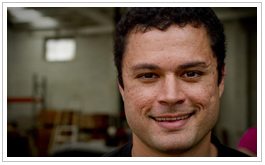Pacific tuna campaigner Duncan Williams answers some questions about the international tuna meeting he’s attending in Brisbane.
 You’ve come all the way from Fiji for this international meeting on tuna. What’s the meeting about and why is it so important?
You’ve come all the way from Fiji for this international meeting on tuna. What’s the meeting about and why is it so important?
Kobe II is the only time that all the tuna commissions from around the world come together to discuss overfishing issues. These organisations are responsible for managing our tuna sustainably, and in many cases they’ve failed.
Tuna is overfished in many parts of the world. For example, Bluefin tuna is critically endangered in the Mediterranean Sea and the Southern Ocean. In the Pacific, Bigeye and Yellowfin are overfished.
Most of the world’s tuna comes from your home in the Pacific. How is the tuna industry affecting Pacific Islanders?
In the Pacific, we fish on a daily basis to feed our families, the same way we did many centuries ago. But things have drastically changed.
Ask any Pacific Islander about the fish in their waters and the story is the same wherever you go – there are fewer fish in the waters and fishermen have to travel further away to catch enough to feed their families. Friends and relatives of mine that work as semi-commercial fishermen are all complaining of the declining number of fish in the seas and the lower income they receive.
We have a lot to lose if fishing continues on its current unsustainable path. Even though the Pacific is the most productive tuna fishery in the world, just one in 20 fishing boats there are from the Pacific Islands. Most tuna is fished, or even stolen, by foreign fleets from countries like Japan, Korea and Taiwan.
Fishing needs to be sustainable and equitable, so that Pacific Islanders have a greater share and responsibility in protecting tuna.
What solution is Greenpeace proposing?
Greenpeace wants leaders at this meeting to declare a ban on destructive fishing practices such as FADs (or Fish Aggregation Devices). FAD fishing is responsible for the sharp decline in tuna and the wasteful catch of turtles and sharks. Greenpeace is urging Pacific Island countries to become leaders in the governance of oceans by declaring a ban on FADs.
Can you explain what a FAD is and how it works? Why are they so bad?
A FAD is an artificial reef designed to attract tuna and other marine animals. FADs alone are not the problem. When FADs are used together with purse seine nets, they become part of a deadly combination. A purse seine vessel lays a single net capable of encircling multiple city blocks around the FAD, taking everything including turtles, sharks and small tuna that haven’t had a chance to breed. This is highly destructive and needs to stop.
How can we all help stop overfishing?
As consumers, we have a major role to play in helping to stop overfishing. We can start by choosing sustainably caught tuna at the supermarket.
» See how Australian canned tuna brands rate on sustainability

